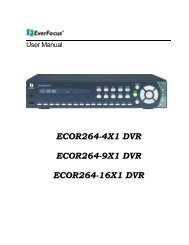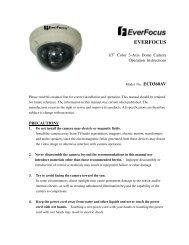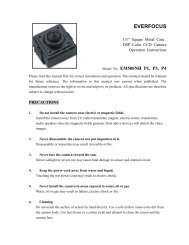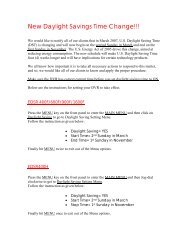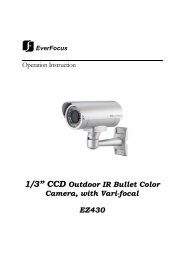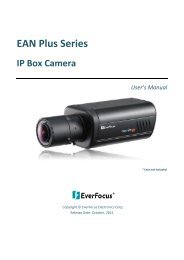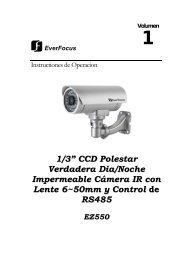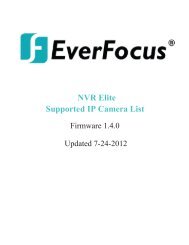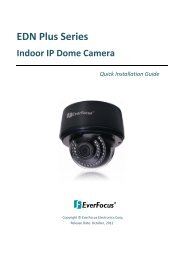DDNS Setup Instructions - Everfocus
DDNS Setup Instructions - Everfocus
DDNS Setup Instructions - Everfocus
You also want an ePaper? Increase the reach of your titles
YUMPU automatically turns print PDFs into web optimized ePapers that Google loves.
<strong>DDNS</strong> <strong>Setup</strong> <strong>Instructions</strong><br />
Applies to Paragon, ECOR, Paragon264, Paragon HD, ECOR264, EDR264, EDR HD and EDR/EDVR<br />
Note: On EDR/EDVR you MUST have firmware version 1.6.2 or higher installed in order to<br />
use the EverFocus <strong>DDNS</strong> service.<br />
1. Set up the DVR Network Menu according to the instructions detailed in the Networking chapter of<br />
the DVR’s manual.<br />
a. If using DHCP, all settings will be detected automatically. While DHCP is a useful tool for<br />
determining the network settings, if you set up your DVR in this manner its IP address may<br />
change at different times for different reasons, particularly after a power failure. If the IP<br />
address of the DVR changes, you may have difficulties accessing your DVR locally and/or<br />
remotely. It is strongly recommended that you assign a fixed (static) IP address to your<br />
DVR, and that in order to avoid address conflicts the IP address assigned be outside of the<br />
DHCP range of addresses your router issues to DHCP clients. Please do not set the DHCP<br />
address issued to the DVR by the router as its static IP address unless you take specific steps<br />
that program your router to prevent such address conflicts.<br />
b. If using a Fixed IP (recommended), you will need to input the information manually. In<br />
order for <strong>DDNS</strong> to work, you must enter valid data, compatible with your network, for all<br />
four of the network setting fields: IP address, subnet mask, default gateway and the DNS<br />
Address (depending on your network hardware and configuration this may be the IP address<br />
of your router/gateway, or it may be the actual IP address of the local DNS server).<br />
The DNS server IP is required because your DNS server provides critical information<br />
necessary for the DVR to communicate with the <strong>DDNS</strong> server.<br />
You can obtain the actual DNS IP from your Internet Service Provider (ISP); or, from a PC<br />
located on the same LAN as the DVR, go to http://www.dnsserverlist.org/ to obtain a list of<br />
the IP addresses of their recommendation of the best servers to use for your location.<br />
2. If you are connecting through a router, make sure that you have ‘opened up’ all the required network<br />
ports in the port forwarding section of your router’s setup options. That is, you have directed the<br />
router to send any incoming traffic using those IP ports to the LAN IP address of the DVR. Useful<br />
information about router port forwarding can be found at www.portforward.com<br />
The default ports are Paragon, Paragon264, Paragon HD, ECOR264, EDR264, EDR HD: 80<br />
ECOR (mpeg): 80, 1600<br />
EDR/EDVR: 80, 1600, and 37260 - 37263
Note: Port 80 is the default port used for web browsing. Because of this, in order to prevent the<br />
average user from hosting a web server, most ISPs BLOCK traffic using port 80 from reaching the<br />
average site. If you only plan to view your DVR on a LAN, you can use port 80, and don’t have to<br />
concern yourself with <strong>DDNS</strong> or routers. However, if you desire remote access to your DVR, perhaps<br />
using <strong>DDNS</strong> (optional), you MUST select functional ports and set up the port forwarding in your<br />
router. Other ports, such as 8080 and 8000 are sometimes blocked by ISPs as well.<br />
What port(s) should you use? There are 65,535 valid IP ports to choose from. These are broken<br />
down into three groups:<br />
• Well Known Ports 0 thru 1023<br />
• Registered Ports 1024 thru 49151<br />
• Dynamic and/or Private Ports 49152 thru 65535<br />
So, rather than encounter a port conflict by choosing a port commonly used for another purpose (like<br />
port 25 for SMTP mail or port 448 for secure sockets), choose an ‘unusual’ port number. For<br />
example, add 50,000 to your house number: 50,123 is unlikely to lead to a port conflict. For a list<br />
of the known and registered ports, see http://www.iana.org/assignments/port-numbers<br />
3. The <strong>DDNS</strong> name you choose must be unique; that is, it must not already be in use. Please go to the<br />
website http://everfocusddns.com and check that the name you wish to use is available.<br />
PLEASE NOTE: The name of the DVR cannot include a space, or a dot (period) or any special<br />
characters particularly ~ ! @ # $ % ^ & * ( ) + < > " ; : . ,<br />
4. In the DVR’s Network Menu, go to <strong>DDNS</strong>. Choose “everfocusddns.com” for the Server and put in<br />
your chosen name (verified available and without special characters) for DVR Name/hostname.<br />
5. Press the Select or Submit/Update button to synchronize the DVR with the <strong>DDNS</strong> server. You<br />
should see an indication of “Success” on the screen. If you see “Could Not Find Server” or any other<br />
error message instead, double-check your network settings and <strong>DDNS</strong> name and resubmit the <strong>DDNS</strong><br />
name until you get “Success”.<br />
6. You should now be able to connect by typing in the host name you created.<br />
Example: http://hostname.everfocusddns.com<br />
It is not necessary to append the HTTP port number to the <strong>DDNS</strong> name. The EverFocus <strong>DDNS</strong> server<br />
not only keeps track of your DVR’s IP address, it keeps track of the ports too!<br />
2/3/11



